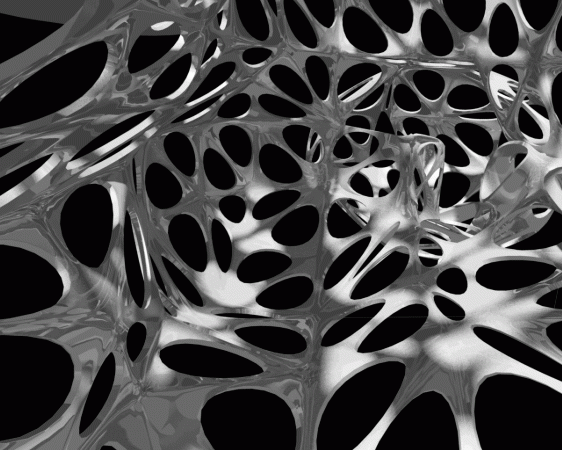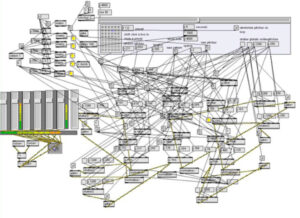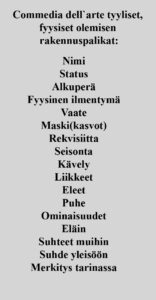

PARAMETRIC ARCHITECTURE
PARAMETRIC DESIGN OF THE STAGE
1. Parametric design and architecture
Parametric design means that, when designing the form of a work of art, certain parameters are specified for its structures but the final artistic solutions are not fully controlled by any single artist. In this type of thinking, artist does not start from the assumption that he is in the position of an “auteur” (or God) who, from above – a controlling position, “signs” the work and takes hold of the copyrights. Because parametric design has originated and been developed from architecture (and the research of digital CAD design), I will first attempt to open this concept through building design and, then, discuss how the actor’s body, beings on stage or the whole theatrical work of art could be a kind of “building” which has been built through the means of parametric architecture. As a result, acting is seen as an analogy of parametric architecture.
In recent years, parametric architecture has, as digital possibilities are explosively increasing, made up ground in the design industry, replacing the traditional architecture which cherishes the purpose of traditional shapes of buildings. Therefore, the process can easily result in a number of different spatial solutions by replacing parameters. Once these types of digital understanding and thinking are used in practice, i.e. the design of doors, rooms and bathrooms, the process results in whole new shapes of environments intended for living and, above all, new thinking of related design methods and the artist’s intentions.
Architect Peter Zellner says:
“Architecture is recasting itself, becoming in part an experimental investigation of topological geometries, partly a computational orchestration of robotic material production and partly a generative, kinematic sculpting of space.” (Zellner:1).
Simply put: An architect previously drew a house, designed its every detail, approved it and signed it as his “product”. Currently, an architect can define parameters (no matter how detailed) and the computer can use these parameters for designing a hundred thousand (or a billion) different houses. The concepts of parametric design did not remain as mere ideas on paper. After literature references at the end of this text, there are online links to some actual building projects implemented through this method.
The concept of architecture has faced massive changes in recent years, even at the level of everyday jargon. Currently, architecture refers to nearly all creative processes where the aim is to achieve an object (e.g., a house) or a structural idea (e.g., a digital environment or data system – and perhaps the actor’s consciously-built stage-body in the future). Discussion within the field of architecture has naturally spread to music and mathematics. Wikipedia, the modern-day collective encyclopaedia, covers the software architecture systems as follows:
“The software architecture of a program or computing system is the structure or structures of the system, which comprise software components, the externally visible properties of those components, and the relationships between them. The term also refers to documentation of a system’s software architecture. Documenting software architecture facilitates communication between stakeholders, documents early decisions about high-level design, and allows reuse of design components and patterns between projects.”
http://en.wikipedia.org/wiki/Software_architecture
However, I will discuss the actor’s body in an older and more conservative context of speaking of architecture as an art of the space or even the built environment. I will examine acting from the perspective where the artist could build the living space, the parameters of which are used for providing the art work (the embodied, theatrical object created by the actor) with space to exist and for shaping it. As a result, the art work can be seen as a house, structure or even a building.
Such processing of space and spatiality raises significant methodological and even political questions related to making theatre at a general level. If the management of the whole is abandoned in the design of an art work, what will happen to the romantic image of the artist? Who will be the authority and owner of the copyrights? It will be challenging to observe how discussion of the character of the design core is transferring to how something is done from what is done. This transition allows the artistic process to be reviewed, i.e., to declare the entry of this process into the stage, to change the artist from an authority into an argument and to raise the hierarchies hidden in the art world to the surface.
Mathematician Mark Burry defines this as follows:
“Emerging critical theory (parametric design) … . has no embarrassment in accepting, or benignly accommodating or even celebrating the accident or the error,” with the implication that the “intellectual value of a perverse giving-up of authorship (‘design’) is neither judged with quizzicality, nor seen as a potential artistic impropriety.” (Burry:4)
2. A sketch of a fantasy concerning a parametric actor
In the following, I will shape a quick picture of what the parametric actor’s body image could look like as a graphic design in my work. I got the original idea from similar graphic system diagrams for the Max-SP protocol. Max-SP is a visual programming language which enables the simultaneous processing of very different media (video, still images, music, text…) because a communicating signal system has been developed between them (http://en.wikipedia.org/wiki/Max_(software)). Patches in Max-SP usually look like this:

Similarly, the “parametric actor” practices various skills and continuously acquires new type of information about the surrounding world that he combines, as necessary, through all possible means with the stage object manifested differently on stage. At times, the object can be an imagined/actual represented person who has a name and, at times, it can be something completely different – anything (even a “green idea”). Parameters are set for the actor (stage object) upon the proposal of the actor, the group or the director. The actor adds these parameters to his existing embodied (structural) parameters and, in the desired manner, shapes his work of art towards a specific direction within these parameters.
In the sketches below, the size of the box represents the impact of a specific parameter on the specific production: the resources used during rehearsals – thinking, time, money… Overlapping boxes represent the overlap and “contamination” of specific parameters with other parameters. Another significant element is the change in the images, particularly in relation to the body’s limits and an increase in “contamination”. The purpose of the illustrated “person” (subjective image of the body) is to represent changes in the image of the body developed throughout the research in relation with the planned parameters. The reader should bear in mind that, at the beginning of the study, “parameters in acting” were seen as a new method which could be defined and used generally. At the end of the study, the question was mainly of a general change in thinking, a transition to new practices, thinking and perceptions.
Furthermore, the attributes within each parameter can be divided into numerous areas. Example:

Inside this parameter, “walking” can be divided into different parameters: slow walking, sneaking, happy walking, rapid walking, running, sitting walking, etc.
The division of parameters can be continued endlessly into smaller and more detailed attributes. The accuracy of the details depends on the limits of management and creativity of each working on his/her stage object (or the desire to exceed them). What is important here, is the simultaneous chopping and accurate planning of single parameters, and their contamination with each other. According to Haraway, “any component can be connected to any other if a correct standard or code can be designed for signal processing using a common language (Haraway:234)”.
I have written the following essays on the selected parameters for this research that I have used when producing theatre performances (the parameters are presented after the essay title in brackets).
- Commedia dell’Arte now! (Commedia dell’Arte-type building blocks for physical elements and the performance’s musical form
- Stanislavski (behaviouristic and social stage, and word-processing techniques)
- Rewarding performance experience (performance elements in embodied experiences)
- Possibilities of political theatre in the era of developed capitalism (aesthetics)
Brief definitions of the parameters:
1. Commedia dell’Arte-type building blocks for physical elements and the performance’s musical form: These parameters refer to the orchestral building blocks for performances. These are the single elements that make up acting/the theatre. In Acting, this begins from the smallest possible part, e.g. single hand movements. This kind of planning of building blocks can also be expanded to other areas of the performance: for set design, the starting point could be the physical parameters of a single chair (object). This parameter also covers how single building blocks are “mixed” with one another. Mixing refers to the production of the “cross-lighting” and “balance” for the desired stage elements.
2. Behaviouristic and social stage, and word-processing techniques: This refers to tools of communication developed between different signals (actors, cybernetic applications, stage objects…). The Meisner method discussed in the Stanislavksi essay or the MAX SP programming language used in MAAILMAN PARAS are examples of such a code.
3. Performance elements in embodied experiences: This refers to the factors that develop performance operations into rewarding experiences.
4. Aesthetics: This includes the parameters prepared in each re-evaluated historical situation for meaningful “political theatre”.
4. Hyperbodies and the “Swarm” architecture
The character of theatre work in the art works included in my research has largely been collective. There has been a varying number of work groups and actors (people and/or machines) on stage, but each art work has been prepared as a team, i.e., the director has had to prepare specific tools of communication for leading the “swarm” three-dimensionally using the parameters required by the art work. If parametric design was studied in the aforementioned manner simply from the point of view of each actor, we would not take this collective attribute of the theatre (swarm, flock) into account.
4.1 Hyperbodies – Towards an E-motive architecture
Kas Oosterhuis is a professor at the Technical University of Delft where he leads the Hyperbody Research Group. In his book, Hyperbodies – Towards an E-motive architecture, he discusses building design models where components communicate with other building components in real time. Therefore, buildings are similar to moving swarms or types of hives. This type of building design assumes that all these individual building parts are independent, intelligent actors that carry information and are capable of processing the information following the parameters given (p.2). This information is parametric and can be operated generally, and it contains “blocks” or “scripts” significant for the essence of the building, as well as the possibility of varying all these parts. In a collective building process, the “swimming” of the swarm, which is the entity of the building, is built through communication between the units (p.3). Oosterhuis is aiming at an ideal of architecture where building design is changed into the design of dynamic and shaping structures where the environment is amidst constant changes, enabling the existence of these buildings in real time. Buildings change into both familiar and unforeseen, similarly to the weather.
In his book, Oosterhuis regards buildings more as bodies than as lifeless “boxes”. This means that all of the visible building parts need to be rethought: walls turn into skin, from limits into surfaces. Windows change into wormholes where the external skin bends back inwards. Doors are windows through the skin, some types of mouths (p.17). All of this changes the objectives of design – individual unique elements are built instead of finished products.
In order for buildings to be parts of a “swarm” or “hive”, they need to possess certain skills, features and communication tools that are at the same level as other units in the swarm (p.58).
Single members of the swarm must possess specific intelligent and learned “stupidity”. In order for the intelligence of the swarm (and the targeted real-time flow) to be fulfilled as a swarm, the information must flow freely within the swarm. A single swarm member cannot stop to reflect on the meaningfulness or quality of a specific data unit, but the unit’s willingness must be directed at learning from the information and recycling it as a spiral. The stoppage of information will kill the swarm and the project it produces (p.59).
Units in the swarm do not position themselves in time and place according to normal XYZ coordinates, but in relation to other swarm members and according to their parameters. As a result, no prevailing or general conditions of “realism” are defined for the art work, but all reality shaped together is both temporal and local. The existence of the swarm is only tied to future and past states (p.59). A single swarm member accepts all possible viewpoints of where the swarm ends up as a whole.
Through his writing, Kas Oosterhuis is aiming at opening new dimensions for architecture. He is working in a digital environment and all of his claims are based on the aim that software designers should abandon all millstones of traditional architecture and building production so that the design components could develop. Such millstones include the limitations that are related to the requirements set for independent building dimensions located in XYZ coordinates, strengthening the assumed prejudices of users, and keeping the prevailing conservative conceptions of the human environment self-evident. Similar millstones are associated with actors: the conservative requirements of the psychological and dramaturgic “truth”, the holistic illusions in “building a character”, and collectively built stage art practices that became outdated years ago in relation to the general development and awareness of society.
Donna Haraway claims that we are all combinations of machines and organisms – cyborgs (Haraway:162). If this is the case, why could not we be influenced in our actual acting processes by the latest digital design ideas and use the already-acquired information for the benefit of this art? If architectural design generated originally in a digital environment was developed into an analogy, even a superficial one, what kinds of deductions and practical actions could be possible? Should the interest of a single actor be aimed at designing and developing single and possibly unique information units? Could the director be the one in a work team who defines or develops these means of communication and data transfer between units? In that case, a swarm which shapes itself in real time would fulfil the types of data editing where its features would best be represented considering a single (building) performance.
This is the type of theatre I would definitely like to experiment on and create in this research.
Theatre which is familiar in many ways, easy to follow and attached to the tradition but, at the same time, unpredictable – similar to the weather.
Sources:
- Burry, Mark (1999). Paramorph. AD Profile 139: Hypersurface Architecture II. Academy Editions. London. Web publication: Kolarevic, Branko (2000) Digital Morphogenesis and Computational Architectures. Day of citation 16.11.2009 [http://cumincades.scix.net/data/works/att/fbc9.content.pdf]
- Haraway, Donna (1991). “A Cyborg Manifesto: Science, Technology, and Socialist-Feminism in the Late Twentieth Century” in Simians, Cyborgs and Women: The Reinvention of Nature pp.149-181. Free Association Books. Routledge. New York.
- Oosterhuis, Kas (2003). Hyperbodies. Towards an E-motive architecture. Birkhäuser. Basel.
- http://fi.wikipedia.org/wiki/Tietojärjestelmäarkkitehtuuri
[webdocument] Wikipedia. [day of citation 1.11.2009] - Zellner, Peter (1999). Hybrid Space: New Forms in Digital Architecture. Rizzoli International Publications. New York. Web publication: La Costa, Andrew (2008) Finding of Form: A departure from the Making of Form. Day of citation 16.11.2009. [http://wiki.uelceca.net/20072008/files/essayAlaC.pdf]
Parametrically designed international building projects:
- Web of North- Holland (http://www.oosterhuis.nl/quickstart/index.php?id=117)
- Soundbarrier | Utrech (http://www.oosterhuis.nl/quickstart/index.php?id=soundbarrier)
- UFA-Cinema Center in Dresden (http://www.emporis.com/building/ufacinemacenter-dresden-germany)
- Beijing National Aquatics Centre (http://en.beijing2008.cn/46/39/WaterCube.shtml)
Mikko Kanninen
Theatre as a Project of a Body - artistic research on the theoretical and practial possibilities of moders acting
*
ACADEMIC DISSERTATION
To be presented, with the permission of the board of School of Communication, Media and Theatre of the University of Tampere,
for public discussion in the Teatterimonttu theatre, D-wing, Kalevantie 4, Tampere on April 22nd, 2012 ay 12 o`clock.
UNIVERSITY OF TAMPERE
(c) Mikko Kanninen 2012
